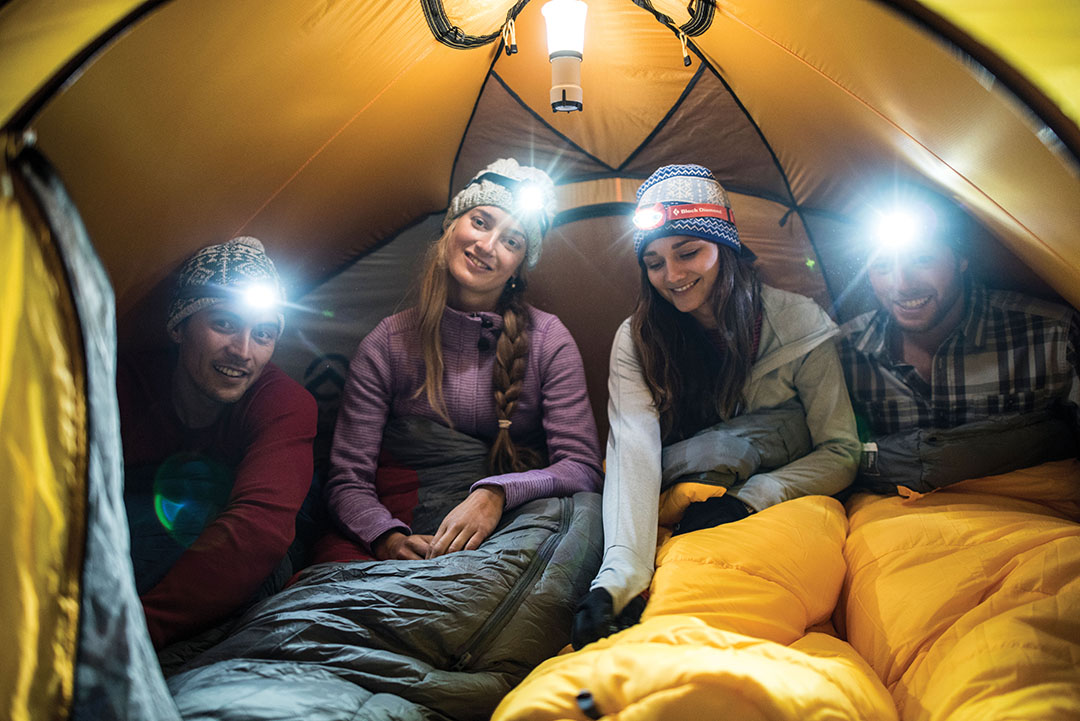Let’s face it, emergencies occasionally happen to folks who recreate outdoors. Having some safety-focused gear in your pack usually makes these unexpected situations a lot more manageable, especially during the colder, winter months. Before heading into the woods this winter, consider adding one of these emergency shelters and some of the following gear to your kit.

Types of Emergency Shelters
Being able to get out of the elements is a critical way to conserve body heat during an emergency. Since there are usually no buildings or vehicles around, having a portable emergency shelter in your pack is a great way to ensure that’s possible. There are three main styles: emergency bivvies, guide tarps, and group shelters.
Emergency Bivvies
Many hikers, climbers, and backcountry skiers carry some form of an emergency bivvy in their pack. Designed as either a super-thin blanket or shaped like a sleeping bag, an emergency bivvy is great for helping you retain body heat, trapping warm air, and providing a barrier against wind and precipitation.
There are four main features to consider when choosing between competing types of emergency bivvies. First, the style—do you want a blanket, which is light and wearable while moving but can blow away, or more of a sleeping bag, which you can get inside? Second, examine the durability of the material—some shred quite easily, which won’t do you much good in windy conditions or on rocky ground. Third, consider the internal lining, as many are designed to reflect body heat back onto you. Finally, determine whether it is a single-use product; some will never fit back into their original packaging.
Prices vary considerably on emergency bivvies. The least expensive—think space blankets and contractor-sized trash bags—cost a couple of dollars at most. Meanwhile, more advanced bivvies, some of which can be used for a lot more than emergencies, cost much more.
As a general matter, the entire category has a few limitations. They typically fit only a single person, provide minimal heat retention, and offer only a thin layer of material to separate you from the elements.
Guide Tarps
Guide tarps have multiple functions—they can serve as bivvy sacks or be used to construct various above-ground shelters (including ones that protect multiple people), build the roof of a snow trench, or package an injured patient and haul them over the snow to safety. They are a particularly popular piece of emergency gear among backcountry skiers and riders.
Typically 1 to 2 pounds in weight, guide tarps are a little heavier and bulkier than the smallest emergency bivvies. But their ability to do double duty makes them a key piece in a winter emergency kit. This is especially true when they are treated as more of a group gear piece, providing supplemental shelter to individuals who are already carrying their own emergency bivvy.
One note: depending on the shelter configuration you’re trying to build, a guide tarp may require additional resources. But often you’ll have many of those on hand already, such as trekking poles for a tarp tent or an avalanche shovel and skis for digging a snow trench.
Group Shelters
For those spending a lot of time above treeline, such as on a winter ascent of Mount Washington, having a portable way to shelter a larger group from the elements is a critical way to keep everybody safe during an emergency. Enter bothy bags (named after the British expression for a mountain hut, Bothy) or group shelters. These are simple, multi-person, waterproof, and windproof temporary shelters made from lightweight fabric.
Group shelters work quite simply: pull it out of its stuff sack, get everybody underneath, and then have everybody sit on an inside edge (which is what keeps the shelter erect). While the shelter doesn’t have a floor, it provides ample protection from wind and precipitation.
Group shelters come in a variety of sizes. The most common are 1-2 person shelters and 3-6 person shelters. The bigger shelters pack down to the size of a 32-ounce Nalgene. The bigger sizes allow multiple people to huddle together, likely generating more heat than an individual would alone.
Gear to Pair with an Emergency Shelter
While emergency shelters are awesome at reducing certain types of heat loss, they don’t reduce conductive heat loss, immediately dry out your wet gear, or offer a means of generating more heat. To that end, it’s important to carry a few additional pieces of gear to use in conjunction with any emergency shelter.
A Ground Insulator
A closed-cell foam pad is an ideal insulator in an emergency situation. When placed between you and the ground, it helps reduce conductive heat loss from your body to the ground—i.e., the direct transfer of heat from something that’s warm (you) to something that’s cold (the frozen ground).
Not carrying a traditional closed-cell foam pad? Maybe your pack has a removable bivvy pad. You can also sit on your pack. Even better—see how much of your body you can fit inside your pack. If you’re climbing, consider spreading your climbing rope out underneath you to serve as an initial ground insulator and create another layer of separation from the snow.
Dry Insulating Layers
If you were engaged in any type of aerobic activity before the emergency that brought you to a stop, it’s likely that your layers were damp, especially if there was any type of precipitation. And now that your body is stopped, it’s going to generate a lot less heat, making it more likely that moisture in your damp layers will begin to freeze.
Having dry layers—like emergency mitts, a puffy coat with an insulated hood, and puffy pants—in your personal kit that you can put on immediately will help minimize this cooling effect. So will having a dry baselayer, as it will allow you to swap out the layer that’s likely the dampest. And while you’re at it, don’t forget to loosen items that restrict circulation as well as remove, if possible, metal items like crampons that conduct heat away from your body.
For those traveling in bigger groups or in the coldest conditions, consider adding a sleeping bag or two to your group gear. When additional safety gear like this is dispersed amongst the group, it ups your margin of safety without adding much weight to any individual’s pack.
A Way to Generate Warmth
The measures addressed so far conserve the heat generated by the body. But conserving that heat may not be enough to keep you warm. Here are a few things you could carry to generate heat in a pinch:
- Chemical hand or body warmers, which you can use to keep your core warm.
- A stove, which you can use to boil water to drink and fill hot water bottles to put inside your layers.
- A fire starter to build a fire if materials are available.
Communications Device
While staying warm in a backcountry emergency is great, getting out of the backcountry is better. Because cell phone coverage can be quite limited in some portions of the Northeast, having another communications device like a VHF radio or a two-way satellite communicator like a SPOT or In-Reach is a great way to call in the cavalry.
Traveling in the backcountry during winter poses some unique risks, however, they’re mitigated by carrying an emergency shelter and some cold-weather-focused gear.
Tim Peck and Doug Martland
Tim and Doug met long ago at the Eastern Mountain Sports in Canton, Massachusetts. Bonding over a love of slick Quincy Quarry granite, White Mountain sufferfests, and scheming up adventures while folding tee-shirts, today Tim and Doug collaborate to write about their favorite outdoor activities and occasionally get nostalgic about tee-shirt tables.





